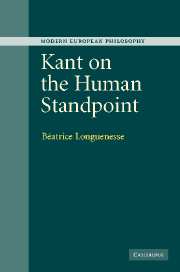Book contents
- Frontmatter
- Contents
- Acknowledgments
- Introduction
- PART I Revisiting the capacity to judge
- PART II The human standpoint in the Transcendental Analytic
- 4 Kant on a priori concepts: the metaphysical deduction of the categories
- 5 Kant's deconstruction of the principle of sufficient reason
- 6 Kant on causality: what was he trying to prove?
- 7 Kant's standpoint on the whole: disjunctive judgment, community, and the Third Analogy of Experience
- Part III The human standpoint in the critical system
- Bibliography
- Index of citations
- Index of subjects
6 - Kant on causality: what was he trying to prove?
Published online by Cambridge University Press: 22 September 2009
- Frontmatter
- Contents
- Acknowledgments
- Introduction
- PART I Revisiting the capacity to judge
- PART II The human standpoint in the Transcendental Analytic
- 4 Kant on a priori concepts: the metaphysical deduction of the categories
- 5 Kant's deconstruction of the principle of sufficient reason
- 6 Kant on causality: what was he trying to prove?
- 7 Kant's standpoint on the whole: disjunctive judgment, community, and the Third Analogy of Experience
- Part III The human standpoint in the critical system
- Bibliography
- Index of citations
- Index of subjects
Summary
Incredible as it may seem, scholars continue to disagree about what exactly Kant was trying to prove in his Second Analogy of Experience – in that section of the Critique of Pure Reason in which he is supposed to provide his response to Hume's skeptical doubt concerning the concept of cause. Since Kant describes this response as the groundbreaking initial step into his critical system, disagreement about its interpretation is not a situation we can easily be satisfied with.
In recent years, a number of new studies have brought valuable insight into the complexities of Kant's argument, as well as into the roots of the persisting disagreements about it. All agree on what constitutes the core of Kant's response to Hume: Kant maintains that some representation of causal relation, rather than resulting – as Hume claimed – from the repeated perception of generically identical successions of events, is presupposed in the very representation of any particular objective succession of states of a thing.
Disagreements, however, have recently focused on two main issues: (1) what is meant by the “objective succession” whose representation, according to Kant, presupposes some representation of causal relation? Is it (a) the succession of events or states of affairs as we perceive them in the objects of our ordinary experience – the freezing of water, the moving of a ship, the warming up of a stone?
- Type
- Chapter
- Information
- Kant on the Human Standpoint , pp. 143 - 183Publisher: Cambridge University PressPrint publication year: 2005
- 1
- Cited by



